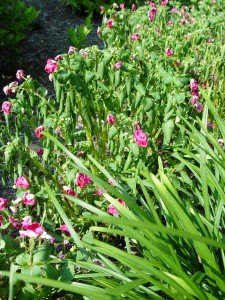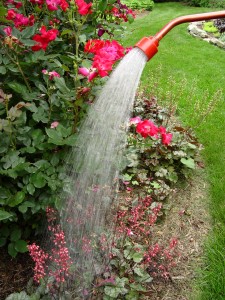H2-Uh-Oh
July 26th, 2011
First, too much. Now, not enough.
Water is a huge factor in the garden. It’s the magic potion that makes plants grow.
Overdo it, though, as was the case this spring, and you’ve got one of the fastest ways to kill a plant.
Underdo it, as has been the case lately, and plants die a slower death.
Getting it right is tricky. Besides the more obvious problem of plants dying from no water in a heat wave, I see a lot of cases where people are wasting water, wasting time and sometimes making things worse.
First is the matter of what to water when.
Don’t over-estimate the value of spotty summer thunderstorms like some of us got on Monday. Even if you’re lucky enough to not get missed, quick dumpings often don’t penetrate into the root zones where the water will actually help.
The first raindrops run off packed mulch and compacted soil, then the next 10 or 15 minutes worth gets sucked up by the mulch on top of the soil. That’s one of the down sides of over-mulching – it can take a soaking rain of at least a half-inch before anything is left to work its way into the soil.
The same is true if you realize it’s bone-dry and try to take things into your own hands.
Most people way under-estimate how much hose water it takes to wet the mulch and then the soil down into the root zone.
Some people assume they’re staying on top of things by getting out there every evening and watering. Unfortunately, that often amounts to little more than cleaning the leaves and dampening the mulch.
A better game plan is to spend enough time on each plant so that the soil at the root level is damp.
Rather than watering everything lightly and regularly, break the beds into zones and water each zone deeply but less often. You might need to go over things several times while watering.
Vegetables, annuals and newly planted perennials will do fine with a good soaking every third day (assuming a soaking rain doesn’t do the deed for you). That’s better than sprinklings every day.
What I do is spend one evening watering the annuals and a few new shrubs out front. Then I water the vegetable garden the next day. Then I spot-water the annuals, the new perennials and drought-wimpy stuff throughout the rest of the yard on the third day. Then I start over.
The exception is potted plants. You’ll probably have to water containers, hanging baskets and window boxes every day in hot, dry weather (assuming you want to keep them alive and can spare the water).
Young trees and shrubs can go every 5 to 7 days between deep soakings.
And most established perennials, trees and shrubs can go 2 weeks or more without any supplemental watering.
You should be able to skip watering established, drought-tolerant perennials, trees and shrubs even in our worst summers. Some examples…
Trees: crabapple, crape myrtle, ginkgo, beech, linden.
Evergreens: falsecypress, juniper, arborvitae, yew, blue spruce, boxwood, cherry laurel, cotoneaster, Hinoki cypress, Leyland cypress, nandina, holly, euonymus, Russian cypress.
Shrubs: abelia, barberry, beautyberry, burning bush, butterfly bush, caryopteris, lilac, sumac, forsythia, ninebark, oakleaf hydrangea, shrub rose (i.e. ‘Knock Out’ and such), spirea, St. Johnswort, viburnum, weigela.
Perennials: most ornamental grasses, amsonia, agastache, aster, baptisia, barrenwort, black-eyed susan, purple coneflower, sedum, salvia, catmint, daylily, dianthus, euphorbia, gaillardia, gaura, goldenrod, most groundcovers, goats beard, hardy geranium, hardy hibiscus, iris, phlox, lamb’s ear, lavender, Lenten rose, liriope, lily, leadwort, Russian sage, Shasta daisy, stokesia, yarrow and yucca.
So how can you tell you’ve added enough water to do any good?
The best gauge is your index finger. Give your watering 30 minutes or so to soak in, then stick your finger down into the ground next to the plant to see how deeply the moisture has penetrated.
That’ll tell you if you’ve watered enough.
Do that once or twice and you’ll know how long you’ve got to water based on your water pressure, the quality and drainage ability of your soil and the root depth of the plants you’re watering.
If your finger isn’t long enough (or if you don’t like sticking your finger in dirt), use a ruler or a stick. If it makes you feel better, buy a soil-moisture gauge.
The key is to get down in there and check. Otherwise, you’re just guessing.
The two best times to water are early in the morning and early evening. Both are times when evaporation is fairly low but when plant leaves will quickly dry off.
That brings me to another watering woe: disease.
This already has been a worse-than-usual disease year because of all the rain we had back in spring. That’s prime time for infections that then plague us throughout the growing season.
When you water over top of leaves, you’re creating the dampness that allows most fungal diseases to thrive.
That’s why whenever you water, it’s best to water directly into the ground and not over the plants. It’s also why early-morning and early-evening waterings are the best timing.
One of the worst things you can do to encourage leaf disease is to water after dark, when the leaves will remain damp for hours.
Drip irrigation is one way to water directly into the ground. Another is using a long-handled watering device, such as a Watering Wand.
Finally, if things are getting really dry and you’re getting concerned about the water bill, your shrinking well level or spending more time with the garden hose than your Sweetie Pie, then it’s time for triage.
It hasn’t come to that yet in my yard, but it has in other years when dry weather degenerates into ungodly drought.
That’s when you have to make the tough decision about what gets watered and what doesn’t.
Personally, I give up on annuals first, figuring they’re going to die at the end of this season anyway.
I also hardly ever water the lawn. (More on this next week.)
And when the chips are really down, I give up on the potted plants, cut back on watering the vegetable garden and let the perennials fend for themselves.
What stays at the top of my list are trees and shrubs planted within the last two or three years. Those are more permanent and more expensive plants that I really don’t want to lose.
Second are any more established trees, shrubs and fruit bushes that are showing early signs of croaking, such as branch diebacks and scorching around the leaf margins.
And third are perennials that just got planted this year.
You might also put any sentimental favorites high on your list.
One other thing… next time I start whining about too much rain, remind me that it beats trying to grow plants in hot dust.










